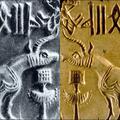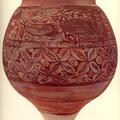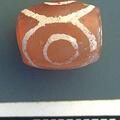Horned Figure Copper Tablet
The large horns could represent the power or virility of the animal; whoever wore the horns would possess similar attributes. According to J.M. Kenoyer, they may depict powerful hunters, shamans or even some form of water buffalo or cattle deity. Asko Parpola writes "a male deity having similar long eyes and bulls horns, but a goat's beard in addition, is known from several terracotta masks and terracotta statuettes" (Indus Script, p. 234).
See also Deity Strangling Tigers Tablet and Parpola's essay Deciphering the Indus Script.










